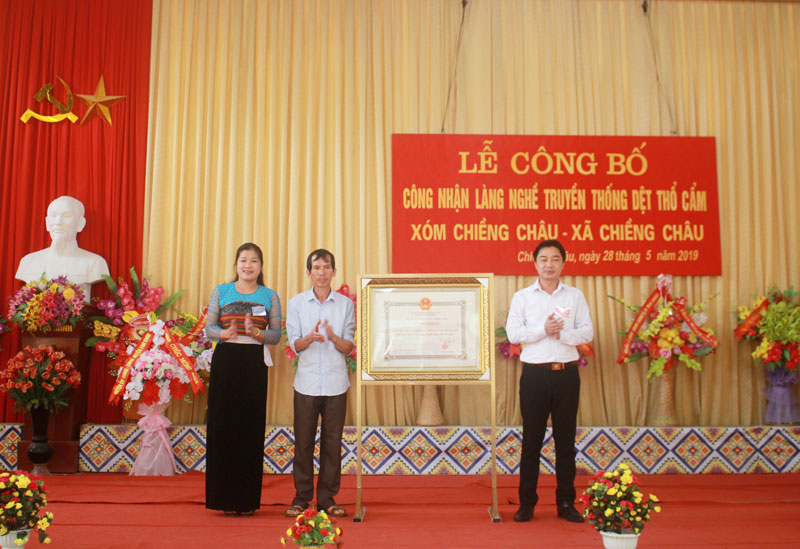
(HBO) - Chieng Chau was recognised as a traditional craft village at a ceremony held in Chieng Chau commune by the communal People’s Committee on May 28.
 Representatives from Mai Chau
district present a decision to Chieng Chau hamlet, Chieng Chau commune, to
recognize the locality as a traditional craft village of brocade weaving.
Representatives from Mai Chau
district present a decision to Chieng Chau hamlet, Chieng Chau commune, to
recognize the locality as a traditional craft village of brocade weaving.
Chieng Chau brocade weaving has
been existing for a long time. In 1955, many handicraft artisans were known. Brocade
weaving in Chieng Chau hamlet recorded the strongest development from
1990-2000.
Most of the households in the
village have 1-2 looms, meeting the shopping need of domestic and foreign
tourists. Brocade values have been improved, contributing to increasing income
for locals.
At present, Chieng Chau brocade weaving is always maintained and developed in the
form of the combination of modernity and traditionality, contributing to the
generation of jobs and income for women, and promoting trade craft tourism potential
to customers inside and outside the locality, thus improving living standards
for locals.
On the occasion, representatives
from Mai Chau district handed over the decision of recognizing Chieng Chau as a
brocade weaving craft village, and presented certificates of merits to 18
outstanding individuals for their contributions to the development of brocade
weaving in the locality./.
The People’s Committee of Lac Son district held a ceremony on April 28 to receive the provincial relic certificate for the ancient rock carving site at Suoi Co stream, located in My Thanh commune.
A special music show titled "The country is in the fullness of joy” has been held at Hoa Binh Square in Hoa Binh city in celebration of the 50th anniversary of the liberation of the South and national reunification (April 30, 1975–2025).
The People's Committee of Lo Son commune, Tan Lac district, has organised the local annual traditional stream fishing festival on April 19 - 20.
As a land deeply intertwined with human history and Vietnam’s millennia-long journey of nation-building and defence, Hoa Binh is often revered for its epic tales and legends.
Residents of Hoa Binh boast a rich cultural identity, reflected in their unique language, traditional attire, customs, and folk melodies – described as "sweet as honey, clear as a mountain stream.”
Lac Son district’s Vu ban town held the 2025 Truong Kha temple festival on April 12–13 (the 15th–16th days of the third lunar month). Since its revival in 2019, the festival has been organised every three years, preserving valuable intangible heritage while meeting the community’s cultural and spiritual needs.



 Representatives from Mai Chau
district present a decision to Chieng Chau hamlet, Chieng Chau commune, to
recognize the locality as a traditional craft village of brocade weaving.
Representatives from Mai Chau
district present a decision to Chieng Chau hamlet, Chieng Chau commune, to
recognize the locality as a traditional craft village of brocade weaving.